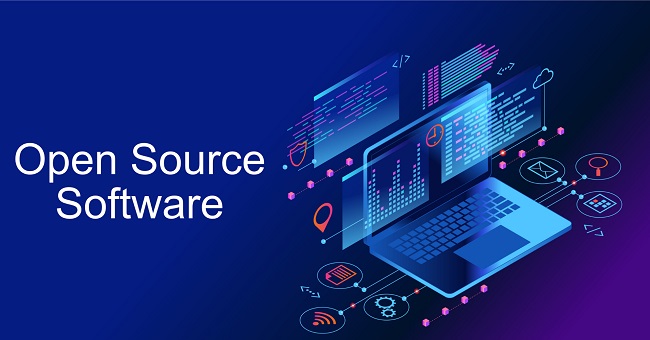Everything is directly or indirectly related to software in these modern times. Not only by our digital devices but also on the way of communication for work, the food style, and almost of the aspect of our life is affected by the presence of software.
Hardware is very difficult to alter and modify. But the software is very dynamic and awesome. As per the system preferences, you can run different types of software on the same hardware as long as possible.

What is Open Source Software?
Open source software refers to software whose source code is freely accessible, modifiable, and distributable by anyone. Unlike proprietary software, where the source code is kept secret and controlled by its creators, open source allows users and developers to collaboratively improve the software.
This approach fosters a community-driven development process where innovation, transparency, and community are paramount.
Read Also:
Understanding Types of Software
It is important to understand before preceding the categories of software. Software are broadly divided and classified into two categories. The first one of this classification is known as proprietary software. Among this type, only the person, team, or organization that created it maintains exclusive control over it and also can be modified.
For example, Photoshop, or say the Windows operating system which are paid. On the other hand, open-source software is those where the source code is available openly. This allows others to view that code, copy from them, learn from it, alter them, or share them.
The open-source software has a great benefit in terms of combination and alteration from different people and sources. It will motivate programmers to access, view, and modify them whenever they like, as long as possible. It will let others do the same when they share their work.
Thus, you have understood the basic and fundamental difference between open-source and proprietary software.
Key Features of Open Source Software
- Accessibility of Source Code: The source code of OSS is openly available for anyone to inspect, modify, and enhance.
- Collaborative Development: OSS encourages community participation in its development, leading to diverse input and rapid innovation.
- Freedom of Use and Distribution: Users can freely use, modify, and distribute the software without licensing restrictions.
- Transparency: The open nature of OSS allows for greater transparency in its development and security.
18 Best Open Source Software of 2024
So, let’s take a look at the best open-source software in 2024.
1. VLC Media Player
VLC Media Player is one of the most popular open-source software. It is a media player which supports almost all formats. Also, there is a chance you already have that on your computer. VLC Media Player is the portable cross-platform media player software.
In addition, its streaming media server developed by the VideoLAN project. It will allow to access all kinds of media formats, both audio and video. The newer update of VLC player also contains support for VR and 360 Degree video content.
Users can also get many kinds of visualizers and other attachment for free as it is open source. It is constantly updating with the growth of technology and is possibly the best open-source media player ever available. VLC media player is available for both PC and Smartphones.
VLC Media Player is supports for PC on Windows, MacOS operating systems. Also, it is available in Smartphones on iOS and Android operating systems.
2. Amarok
Amarok is a powerful open-source music player which has got a really wonderful UI. It is not only made for playing your favourite music, but also it is makes job easier on discovering new music. Amarok shows the lyrics of the song you are listening.
But, it may miss the lyrics of some non-English songs which are available. Users can also edit the metadata of the existing library of song. Also, add cover photos of your choice and also for bookmarks. Additionally, it supports some of the internet radios so that users can relax without bothering to change tracks.
3. Audacious
Audacious is one of the perfect open-source music playing software. It uses less resource use and brings out high audio quality. Also, it support for a wide variety of audio formats. The application is useful for those PCs running on Linux with low specifications.
Additionally, it also works on the Windows platforms as well. Users can drag and drop folders or individual song files which should be played. It also search for artists and albums in entire music library or creates custom playlists.
You can even enrich the sound settings with the graphical equalizer or experiment with LADSPA effects. It also supports for the modern interface which are GTK-themed. Also, you can change things up with Winamp Classic skins.
4. Apache OpenOffice
Apache OpenOffice is a best alternative for Microsoft Office and Google Docs. Unlike the other, it is open-source software which provides its services for free. This software can be used for creating word documents, presentations and spreadsheets.
In addition, it offers Draw (for graphics), Math (for mathematic equations) and Base (for databases). It supports with Microsoft Office documents and helps to import and export Microsoft’s file formats. It is widely known as the successor projects of OpenOffice.org. Also, it is called as the designated successor of IBM Lotus Symphony.
5. LibreOffice
LibreOffice is a type of open-source Office Suite service. Basically, it was one of the parts of the OpenOffice.org project. Later, it forked from the OpenOffice.org project in year 2010. But, this problem did not stop growth of the application.
LibreOffice now comes on the under of The Document Foundation. It provides Writer (for word processing), Calc (for spreadsheets), Impress (for presentations), Draw (for vector graphics), Math (for mathematical formulae) and Base (for databases).
It also compatible with Microsoft’s entire file formats, Just like Apache OpenOffice. Your favoured format can easily import and export into it.
6. Avidemux
Avidemux is open-source software which is a video editor. It can be used for simple cutting, filtering, and encoding process. You can edit many formats like AVI, DVD compatible MPEG files, MP4 and ASF, using different of codecs.
Also, it supports automation of tasks using projects, job queue, and powerful scripting capabilities. It is available for all operating systems like Linux, BSD, MacOS and Microsoft Windows under the GNU GPL license.
7. Open Shot Video Editor
Open Shot Video Editor is another open-source video editor which is free and powerful. It hosts so many features that can actually stand equally with some of the expensive video editors. Open Shot Video Editor allows cutting your footage into multiple parts easily, and adding many tracks and effects as you want.
In addition, it can add audio as waveforms, and also control the speed of your footage. All you have to do is simply drag and drop to add more videos. It has a user interface which is really nice and intuitive.
8. Audacity
Audacity is the best open-source audio editing software among available nowadays. It is settled up with features, accessibility, and plugins. It helps to record live audio, record playback, convert tapes into mp3 other formats. It edits WAV, AIFF, FLAC, MP2, MP3 or OggVorbis sound files and so on.
Also, it can do other basic tasks like effects, reduce noise, change pitch and tempo, isolate vocals, generate tones, etc. But, the best feature of Audacity is that it supports external plugins. Thus, by this reason, more functionality can be added in the future.
Audacity is the multiplatform audio editing software which works on Windows, Mac, and Linux.
9. qBittorent
The qBittorrent is an open source and cross-platform of BitTorrent client. The qBittorrent is a native application and written in C++. It used to Boost, Qt toolkit, and libtorrent-rasterbar library. Its search engine, which is optional, is written in Python.
You don’t get any ads, that like Utorrent, and it has a similar looking interface to Utorrent. User will get support for bandwidth scheduler, Torrent creation tool, IP Filtering, and also IPv6 compliant. The qBittorent is available on all platforms Windows, Linux, MacOS, FreeBSD, OS/2.
10. GIMP
GNU Image Manipulation Program (GIMP) is the best free and open-source alternative to Adobe’s Photoshop. It can be helped for image retouching and editing, free-form drawing, converting between different image formats, and more tasks.
Spencer Kimball and Peter Mattis created GNU Image Manipulation Program in 1995. Since then, it has been updated many times to keep up with the times. You can further enhance your productivity with GIMP whenever you want with many customization options and 3rd party plugins.
GIMP is multiplatform software which is available for Windows 10, Linux, and MacOS.
11. 7zip
7zip is open-source software and famous for compressing and extracting files. Igor Pavlov has created it and was first released in 1999. 7-Zip has got its own 7z archive format. But, it can read and write several other archive formats as well.
Packing/unpacking supported formats: 7z, XZ, BZIP2, GZIP, TAR, ZIP and WIM
Unpacking only supported formats: AR, ARJ, CAB, CHM, CPIO, CramFS, DMG, EXT, FAT, GPT, HFS, IHEX, ISO, LZH, LZMA, MBR, MSI, NSIS, NTFS, QCOW2, RAR, RPM, SquashFS, UDF, UEFI, VDI, VHD, VMDK, WIM, XAR, and Z.
Thus, 7zip is created only for Windows platforms. But, it’s command-line based versions for Linux available.
12. Tor Browser
Tor Browser is an open-source privacy-centric browser. It lets you to access the internet without getting tracked. Tor Browser is a modified version of the Firefox ESR browser. The name is obviously an acronym for The Onion Project. It brings out HTTPS everywhere, NoScript, and other patches to protect privacy and security.
Tor Browser is a perfect option for people who don’t want to show their identity of the internet and browse anonymously. The Tor browser reroutes the traffic through various nodes on the Tor network to do this. It will also delete cookies and web history as the user shuts the browser window.
13. Mozilla Thunderbird
Mozilla Thunderbird is an open-source email reader. It was launched 2004. It is a nice alternative for Outlook if you are in search of all open-source. It includes a Calendar, Chat client, and can receive RSS feeds other than emails.
14. KeePass
KeePass is an open-source password manager especially for Windows operating systems. By the use of Mono, it support for MacOS and Linux operating systems. Setting similar passwords for all of them is dangerous if you have a lot of online accounts.
KeePass helps set different passwords for all of your accounts and then keep them safe. Users can all passwords in one KeePass database, which is locked with a master key. So now, you only have one single master password to unlock the whole database.
The databases are encrypted using the best and most secure encryption algorithms (AES and Twofish) which are very secure.
15. DC++
DC++ is free and open-source file-sharing software. It can be used to connect to the Direct Connect network. DC++ was created by Jacek Sieka. It allows you to share files over the Internet without any restrictions or limits. The application is completely free of ads and has a best and easy to use interface.
Firewall and router support are integrated within the application and it is simple and convenient. To use functionality like multi-hub connections, auto-connections and resuming of downloads and more. DC++ has got more than 50 Million downloads and is the most ranked projects on Sourceforge.
16. BRL-CAD
BRL-CAD is a strongest open-source cross-platform which has a solid modelling system. It includes interactive geometry editing, high-performance ray-tracing for rendering and geometric analysis, a system performance analysis benchmark suite, geometry libraries for application developers.
BRL-CAD has got more than 30 years of active development and is considered to be one of the finest applications for CAD development. It has been the primary tri-service solid modelling CAD system used by the U.S. military to model weapons systems for vulnerability and lethality analyses.
BRL-CAD comes under OSI approved license terms. BRL-CAD is available for platforms like Linux, MacOS as well as Windows.
17. Inkspace
Inkspace is open-source software for professional vector graphics editor. It has got drawing tools that helps to do to a lot of different kinds of users. Also, it has broad file format compatibility so that you can save it in any format. Users can use Inkspace to create or edit vector graphics such as illustrations, diagrams, line arts, charts, logos, and complex paintings.
18. Blender
Blender is one of the best, free and open-source 3D creation suites. It includes the creating of animated films, visual effects, art, 3D printed models, motion graphics, interactive 3D applications, and computer games.
It also has 3D modelling, rigging, animation, simulation, rendering, compositing and motion tracking, video editing and 2D animation pipeline. It is a nice software application for individual artists, professionals, hobbyists, scientists, students, VFX experts, animators, game artists, modders, etc.
It is a very powerful tool and the best part is that Blender is open-source. It is available for all platforms such as Windows, MacOS, and Linux.
Benefits of Open Source Software
- Cost-Effectiveness: OSS can significantly reduce costs, as it is usually free and doesn’t require expensive licenses.
- Flexibility and Customization: Users can modify OSS to suit their specific needs, offering unparalleled flexibility.
- Enhanced Security: With many eyes scrutinizing the code, security vulnerabilities can be quickly identified and addressed.
- Community Support: OSS is supported by a robust community of developers, ensuring continual improvements and support.
- Promotes Innovation: The collaborative nature of OSS fosters innovation, as developers from various backgrounds contribute unique ideas.
Challenges and Considerations in Open Source Software
Despite its advantages, OSS also presents certain challenges:
- Resource Intensity: Maintaining and updating OSS can require significant resources and expertise.
- Varying Quality: The quality of OSS can vary, with some projects being more mature and stable than others.
- Security Concerns: While OSS is generally secure, poorly maintained projects can be vulnerable to security threats.
- Compatibility Issues: Integration of OSS with existing systems and software can sometimes be challenging.
Impact of Open Source Software
Open source software has had a profound impact on the tech industry:
- Driving Innovation: OSS has been at the forefront of major technological advancements, contributing to areas like operating systems (e.g., Linux), web servers (Apache), and programming languages (Python).
- Empowering Startups and Enterprises: OSS enables startups and large enterprises to build and scale applications rapidly without the constraints of proprietary software.
- Fostering Collaboration: It has created a culture of collaboration and knowledge sharing that transcends organizational boundaries.
Read Also:
FINAL WORDS
There were many open source software are available on internet for completing different purposes. It includes software for playing music and video to alternatives of MS office. This article includes some of the really awesome open-source software.
This will also help you on understanding about such kind of software. Therefore, check on internet for one of them and get access to its service for free










